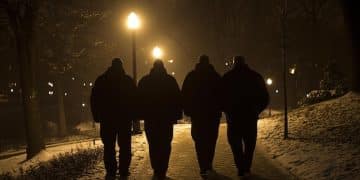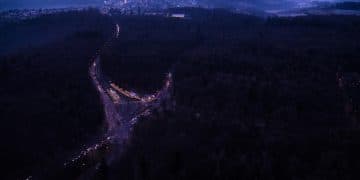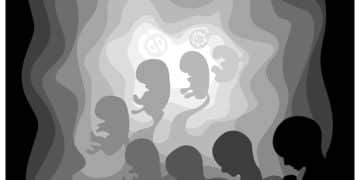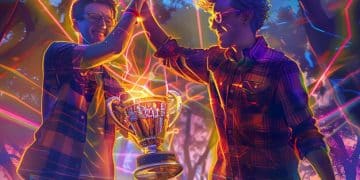Yellowjackets Season 3: Cannibalism Red Herring – Theories & Explanations
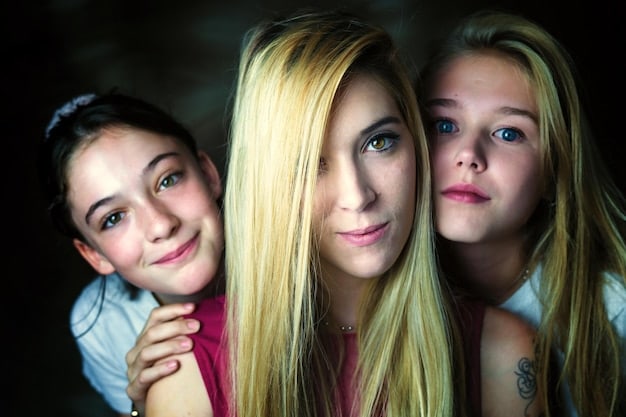
The question of whether cannibalism in Yellowjackets‘ forthcoming Season 3 is a misdirection has ignited extensive fan speculation, probing beyond the obvious survival horror trope to explore psychological trauma, cult dynamics, and potential supernatural influences as primary drivers of the characters’ extreme behaviors and mysterious occurrences in both past and present timelines.
As fans eagerly anticipate Yellowjackets’ third season, one question looms large: is the much-speculated cannibalism merely a misdirection, or a pivotal plot point? The depth of discussion surrounding ‘Yellowjackets’ Season 3: Is Cannibalism a Red Herring? Exploring the Fan Theories and Alternative Explanations suggests that the show’s creators have masterfully crafted a narrative designed to provoke thought far beyond simple survival horror.
The Allure of the Wilderness: Beyond Mere Survival
The wilderness setting in Yellowjackets is far more than just a backdrop; it’s a character in itself, actively shaping the girls’ descent into primal behavior. While the immediate threat of starvation undeniably pushes the characters to extreme measures, many fan theories propose that the isolation and the environment itself play a deeper, more insidious role.
The vast, unforgiving landscape acts as a crucible, stripping away societal norms and exposing raw human impulses. This primitive environment offers an ideal canvas for exploring the limits of human endurance and morality, suggesting that the drive to survive might be intertwined with something far more ancient and unsettling.

Psychological Breakdown Amidst Isolation
Prolonged isolation, coupled with extreme trauma, is a potent catalyst for psychological breakdown. The girls’ mental states deteriorate rapidly, leading to hallucinations, paranoia, and a distorted perception of reality. These elements could individually or collectively explain many of the more gruesome acts without necessarily resorting to literal hunger-driven cannibalism as the sole motivator.
- Shared Delusions: The group might begin to experience collective delusions, where their shared trauma creates a distorted reality.
- Altered States: Hunger, fatigue, and even potential consumption of psychoactive natural elements could induce altered states of consciousness.
- Regression to Primal Instincts: Stripped of civilization, the survivors may regress to primitive behaviors, not out of malice, but out of a desperate, often unconscious, drive for control and purpose.
The show frequently blurs the lines between reality and hallucination, leaving viewers to question the true nature of events. This ambiguity is crucial for understanding the potential red herring. If key moments suggesting cannibalism are filtered through traumatized minds, their literal interpretation becomes suspect.
Ultimately, the wilderness serves as a mirror, reflecting the darkest aspects of the human psyche back onto the survivors. It challenges not only their physical endurance but their moral fiber, pushing them to redefine what it means to be alive.
The Supernatural Element: A Driving Force or a Diversion?
From the outset, Yellowjackets has deliberately woven in elements of the supernatural, hinting at an ancient, malevolent force at play in the wilderness. This presents a compelling counter-argument to the purely survival-of-the-fittest narrative. Is cannibalism merely a symptom of this supernatural influence, or is the supernatural itself a symbolic representation of the trauma that unravels the girls?
The whispers in the woods, the unexplained occurrences, and the growing belief in a forest spirit or entity all suggest that something beyond the mundane is influencing the girls’ actions. This could manifest as coercion, possession, or a slow, insidious corruption of their minds and spirits.
Lottie Matthews and the Cult Dynamic
Lottie’s burgeoning role as a spiritual leader, both in the past and present timelines, is central to the supernatural theories. Her visions and apparent ability to connect with the wilderness’s energy could explain the group’s increasingly ritualistic behavior. This cult dynamic, fueled by desperation and a desperate need for meaning, could easily lead to extreme acts, including human sacrifice or ritualistic consumption, that are driven by belief rather than hunger.
- Ritualistic Practices: The girls’ acts may be born out of a misguided attempt to appease a perceived entity, rather than simply to survive.
- Charismatic Influence: Lottie’s charisma could manipulate the group into performing acts they wouldn’t otherwise consider, under the guise of spiritual necessity.
- Sacrificial Rites: The gruesome acts could be interpreted as sacrifices to the wilderness, a means of survival through spiritual appeasement.
The present-day storyline further emphasizes Lottie’s continued influence and the enduring power of her wilderness philosophy. Her wilderness cult provides a framework through which the girls’ past actions, including cannibalism, could be reinterpreted as dark spiritual rites rather than acts of sheer depravity.
The supernatural elements provide a layer of complexity, suggesting that the cannibalism, if it occurred, might have been a forced or ritualistic act, rather than a desperate last resort due to hunger.
The Allegory of Trauma: How Past Shapes Present
At its core, Yellowjackets is a profound exploration of trauma and its long-lasting effects. The wilderness ordeal is not just a historical event; it’s a living entity that continues to shape the adult survivors’ lives. Viewing cannibalism as a red herring within this context means questioning whether the narrative is using a visceral image to symbolize deeper, more pervasive psychological wounds.
The show consistently flashes between the past and present, highlighting the parallels and the enduring impact of the 1996 plane crash. The survivors are haunted, not just by memories of their actions, but by the very essence of the wilderness experience itself. This suggests that the true horror lies not in what they ate, but in what they became.
Symbolic Interpretations of Flesh and Consumption
Instead of literal flesh-eating, the “cannibalism” could symbolize the girls “consuming” each other in other ways—emotionally, psychologically, or socially. The act could represent the devouring of innocence, trust, or even sanity. This symbolic interpretation allows the show to explore complex themes without being limited by a literal, gruesome act.
- Emotional Betrayal: The girls might have “eaten” away at each other through betrayal, manipulation, and the tearing down of their former selves.
- Loss of Self: The consumption could symbolize the loss of individual identity, as they merge into a primal, collective entity for survival.
- The Wilderness Within: The wilderness’s influence could be internal, leading them to psychologically cannibalize their past selves and memories.
The show’s power lies in its ability to hint at unspeakable acts while focusing on the psychological toll. The implications of literal cannibalism are profound, but the metaphorical consumption of trust, hope, and even humanity might be the more central and terrifying truth the series aims to convey.
This perspective shifts the focus from the physical act to the metaphorical meaning, portraying cannibalism as a symbolic representation of the destruction they inflicted upon each other and themselves.
Survival Instinct vs. Moral Decay: A Fine Line
The premise of survival horror often hinges on the degradation of morality under extreme pressure. In Yellowjackets, the question is whether the girls crossed the line due to pure necessity or if their moral compasses simply deteriorated in such an unforgiving environment. The debate around cannibalism being a red herring suggests that the latter might be the case, implying a more nuanced exploration of human nature.
Is survival at all costs truly noble, or does it inevitably lead to a loss of humanity? The show challenges viewers to confront this ethical dilemma. The acts committed in the wilderness are not just about staying alive; they are about defining what kind of person emerges from the crucible.
The Cost of Surviving
Even if literal cannibalism occurred, the show makes it clear that survival came at a terrible price. The adult survivors are deeply scarred, grappling with unresolved trauma, guilt, and a desperate need to suppress or reframe their past. This psychological aftermath is perhaps more disturbing than the acts themselves.
- Unbearable Guilt: The survivors carry immense guilt, regardless of the literal interpretation of their actions.
- Coping Mechanisms: Their present-day behaviors are elaborate coping mechanisms to deal with the unspeakable.
- Reinventing Reality: They have collectively woven a tapestry of denial and self-deception to make their past bearable.
The show effectively portrays how the survivors’ past actions, whatever they truly were, continue to dictate their present lives and relationships. The “cannibalism” may be the ultimate trauma they collectively try to bury, whether it was a physical act or a symbolic manifestation of their profound moral compromises.
This exploration ensures that the audience remains invested in the characters’ psychological journeys, rather than just the sensationalism of the “what happened out there” question.
The Clues and Disinformation: Unpacking the Narrative
The show’s creators have been adept at scattering clues and hints, often leading viewers down multiple interpretive paths. This narrative strategy is key to the “red herring” theory. What appears to be explicit evidence of cannibalism might, upon closer inspection, be an intentional misdirection to conceal a darker, more complex truth.
Every fleeting glance, every cryptic line of dialogue, and every unsettling visual can be reinterpreted to support or refute the cannibalism narrative. The reliance on suggestion and implication rather than explicit depiction creates a rich ground for fan speculation.
Misinterpretations and Ambiguity
The premiere episode’s infamous pit scene, depicting a ritualistic hunt and consumption, has been central to the cannibalism theories. However, the scene is deliberately ambiguous, allowing for interpretations beyond literal human flesh. Was it a hallucination? A symbolic act? Or something else entirely masked by the trauma?
- Visual Metaphors: What some see as clear evidence, others interpret as symbolic imagery.
- Unreliable Narrators: The adult survivors’ fragmented memories and deliberate omissions make them unreliable storytellers.
- Audience Projection: Viewers often project their own expectations and fears onto the ambiguous scenes.
The creators have skillfully played with audience expectations, presenting horrifying scenarios that appear to confirm the worst, only to subtly introduce elements that complicate the narrative. This constant shifting of perspective keeps the audience engaged and theorizing.
The “red herring” is not about a lack of evidence, but about a deliberate manipulation of it, leading the audience towards a sensational conclusion while concealing the true, perhaps even more terrifying, underlying story.
Fan Theories vs. Showrunner Intent: What to Expect from Season 3
The internet is awash with elaborate fan theories, each attempting to unravel the mysteries of Yellowjackets. While some theories lean heavily into the supernatural, others focus on psychological thrillers, and a significant portion actively debates the true nature of the cannibalism. For Season 3, the creative team faces the challenge of satisfying these expectations while maintaining the show’s unique blend of horror and drama.
The showrunners have often expressed their enjoyment of these fan discussions, indicating that they appreciate the deeper engagement. This suggests that they are aware of the “red herring” possibility and might even be planning to exploit it.
Will They Confirm or Deny?
Season 3 holds the key to many unanswered questions. Will the show finally offer a definitive answer regarding the extent and nature of the cannibalism, or will it continue to dance around the edges, letting the psychological and supernatural elements take precedence? The most compelling narrative choice might be to keep the ambiguity alive.
- Subversion of Expectations: The show could deliberately subvert expectations, revealing a truth more disturbing than literal cannibalism.
- Focus on Aftermath: The focus might shift entirely to the aftermath of their actions, rather than graphic depictions.
- Deepening the Mystery: Maintaining elements of ambiguity could keep the narrative fresh and allow for more seasons.
The beauty of Yellowjackets lies in its ability to be many things at once: a survival horror, a psychological drama, a supernatural thriller, and a dissection of trauma. For Season 3, the resolution of the cannibalism question, whether confirmed or revealed as a red herring, will define the show’s legacy.
The creative team’s challenge will be to deliver an ending (or a new beginning) that is both shocking and emotionally resonant, regardless of the ultimate nature of the cannibalism.
| Key Point | Brief Description |
|---|---|
| 🔄 Cannibalism as Red Herring | Many fan theories suggest the show uses implied cannibalism to mask deeper psychological, cultic, or supernatural themes. |
| 🧠 Psychological Trauma | Extended isolation and trauma lead to psychological breakdowns, potentially causing delusions or symbolic “consumption.” |
| ✨ Supernatural Influence | The wilderness may possess a malevolent force, potentially driving ritualistic acts or possession rather than hunger. |
| 🔍 Narrative Ambiguity | Showrunners deliberately use hints and unreliable narrators, allowing for diverse interpretations of the girls’ actions. |
Frequently Asked Questions About Yellowjackets Season 3 Theories
▼
The “red herring” theory suggests that while cannibalism is heavily implied and visually disturbing, it might be a clever narrative device used by the showrunners to distract from deeper, more complex themes. These themes could include psychological trauma, the formation of a cult, supernatural influences, or metaphorical “consumption” of trust and innocence among the survivors, making the literal act less central than its underlying causes or symbolic meaning.
▼
Psychological trauma is a cornerstone of many fan theories. Prolonged isolation, starvation, and extreme stress can lead to severe mental deterioration, including hallucinations, shared delusions, and a regression to primal instincts. Some theories propose that the gruesome acts depicted are a result of these altered mental states, not necessarily literal cannibalism, or that the “consumption” is symbolic of profound emotional and mental breakdowns.
▼
The show frequently hints at a malevolent, ancient force in the wilderness, influencing the girls. Theories suggest this supernatural entity might actively coerce or possess the survivors, leading to ritualistic acts, including human sacrifice or consumption, that are driven by spiritual appeasement rather than pure hunger. Lottie’s transformation into a spiritual leader further bolsters the idea that cult-like practices, influenced by external forces, explain their behaviors.
▼
Yes, many theories interpret the cannibalism symbolically. Instead of literal flesh-eating, it could represent the emotional or psychological “devouring” of each other. This includes the destruction of trust, the loss of individual identity, or the way their shared ordeal forces them to consume their former innocent selves. This metaphorical interpretation allows the show to explore the profound moral and psychological degradation without relying solely on the shock value of physical acts.
▼
Season 3 is expected to delve deeper into the mysteries of the wilderness and the true nature of the girls’ actions. While it could offer definitive answers about the cannibalism, the show’s history of narrative ambiguity suggests it might continue to blur lines, focusing instead on the characters’ lasting trauma and the psychological aftermath. The creators might choose to confirm, deny, or further complicate the “red herring” theory, keeping audiences engaged in the complex narrative.
The Unfolding Enigma of Survival
As Yellowjackets gears up for its third season, the discourse surrounding whether cannibalism functions as a red herring reflects the show’s intricate storytelling. It’s a testament to the creators’ skill that such a visceral concept can be so deeply interrogated, leading to discussions that transcend mere plot points and delve into the human condition itself. Whether the girls literally consumed each other or if the horror lies in a more psychological, symbolic, or supernatural interpretation, the fact remains that the wilderness undoubtedly transformed them, leaving scars that resonate decades later.

